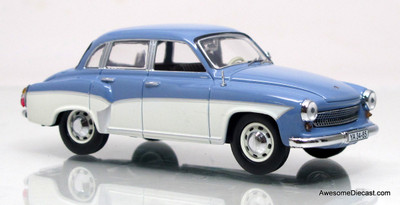Esval Models
Esval Models 1:43 1921 Pierce Arrow Model 32 7 Seat Limousine, Blue

Esval Models 1:43 1921 Pierce Arrow Model 32 7 Seat Limousine, Blue
$89.99
This resin model is 1 of only 250 pieces produced world wide
The Pierce-Arrow Motor Car Company was an American motor vehicle manufacturer based in Buffalo, New York, which was active from 1901 to 1938. Although best known for its expensive luxury cars, Pierce-Arrow also manufactured commercial trucks, fire trucks, boats, camp trailers, motorcycles, and bicycles.
The forerunner of Pierce-Arrow was established in 1865 as Heinz, Pierce and Munschauer. The company was best known for its household items, especially its delicate, gilded birdcages. In 1872, George Norman Pierce (1846–1910) bought out the other two principals of the company, changed the name to the George N. Pierce Company, and in 1896 added bicycles to the product line. The company failed in its attempt to build a steam-powered car in 1900 under license from Overman, but by 1901, had built its first single-cylinder, two-speed, no-reverse Motorette. In 1903, it produced a two-cylinder car, the Arrow.
In 1904, Pierce decided to concentrate on making a larger, more luxurious car for the upscale market, the Great Arrow. This became the company's most successful product. The solidly built, four-cylinder car won the Glidden Tour in 1905, an endurance run to determine and celebrate the most reliable car. Thirty-three cars entered the 350-mile race from New York City to Bretton Woods, New Hampshire; the race was won by Percy Pierce in a Great Arrow.
The noted industrial architect Albert Kahn designed the Pierce Arrow Factory Complex at Elmwood Avenue and Great Arrow Avenue in about 1906. It was listed on the National Register of Historic Places in 1974. George Pierce sold all rights in the company in 1907, and he died three years later. In 1908, Pierce Motor Company was renamed as the Pierce-Arrow Motor Car Company.
In 1910, George Pierce died. In 1912, Herbert M. Dawley (later a Broadway actor-director) joined Pierce-Arrow, and he designed almost every model until 1938. Until 1914, Pierce-Arrow also made a line of motorcycles, including the Pierce Four.
In 1914, Pierce-Arrow adopted its most enduring styling hallmark when its headlights were moved from a traditional placement at the radiator's sides, into flared housings molded into the front fenders of the car. This gave the car an immediately visible distinction in front or side views. At night, the car appeared to have a wider stance. Pierce patented this placement, which endured until the final model of 1938, although Pierce always offered customers the option of conventional headlamps; only a minority ordered this option.
The Pierce-Arrow was a status symbol, owned by many Hollywood stars and tycoons. Most of the royalty of the world had at least one Pierce-Arrow in its collection. Some have described Pierce and two of its rivals among American luxury cars, Peerless and Packard, as the "Three P's of Motordom." Industrial efficiency expert Frank Gilbreth extolled the virtues of Pierce-Arrow, in both quality and in its ability to safely transport his large family. Its wheelbase was 12 ft 3 in (3.73 m). The transmission was a four speed manual in 1919. Actor Sessue Hayakawa (famed for his role in Bridge on the River Kwai) drove a custom-ordered gold-plated Pierce-Arrow. A restored 1919 Pierce-Arrow is on display at the Woodrow Wilson Presidential Library. An open-bodied Pierce-Arrow carried Woodrow Wilson and Warren G. Harding to Harding's 1921 inauguration, and one was used prominently in the 1950s movie Cheaper by the Dozen.
Pierce-Arrow advertisements were artistic and understated. Unusual for car advertising, the image of the car was in the background rather than the foreground of the picture. Usually, only part of the car was visible. The Pierce-Arrow was typically depicted in elegant and fashionable settings. Some advertisements featured the car in places a car would not normally go, such as the West and other rural settings, a testament to the car's ruggedness and quality.
Because of the immense size of most models, several second-hand Pierce-Arrow cars were bought by fire departments, stripped down to the chassis and engine, the wheelbase lengthened, and built back into fire engines. Some of these fire engines were in service for up to 20 years.



















